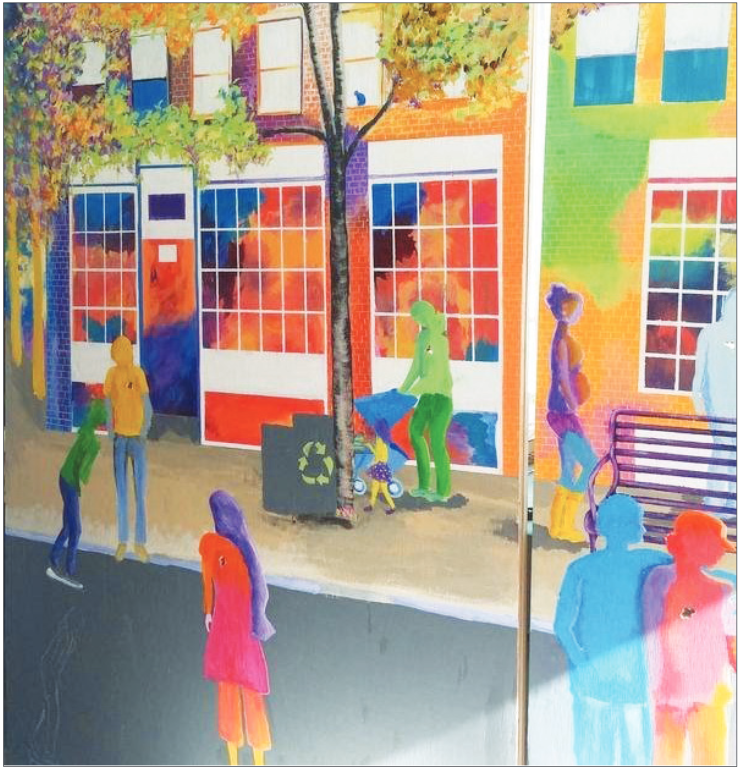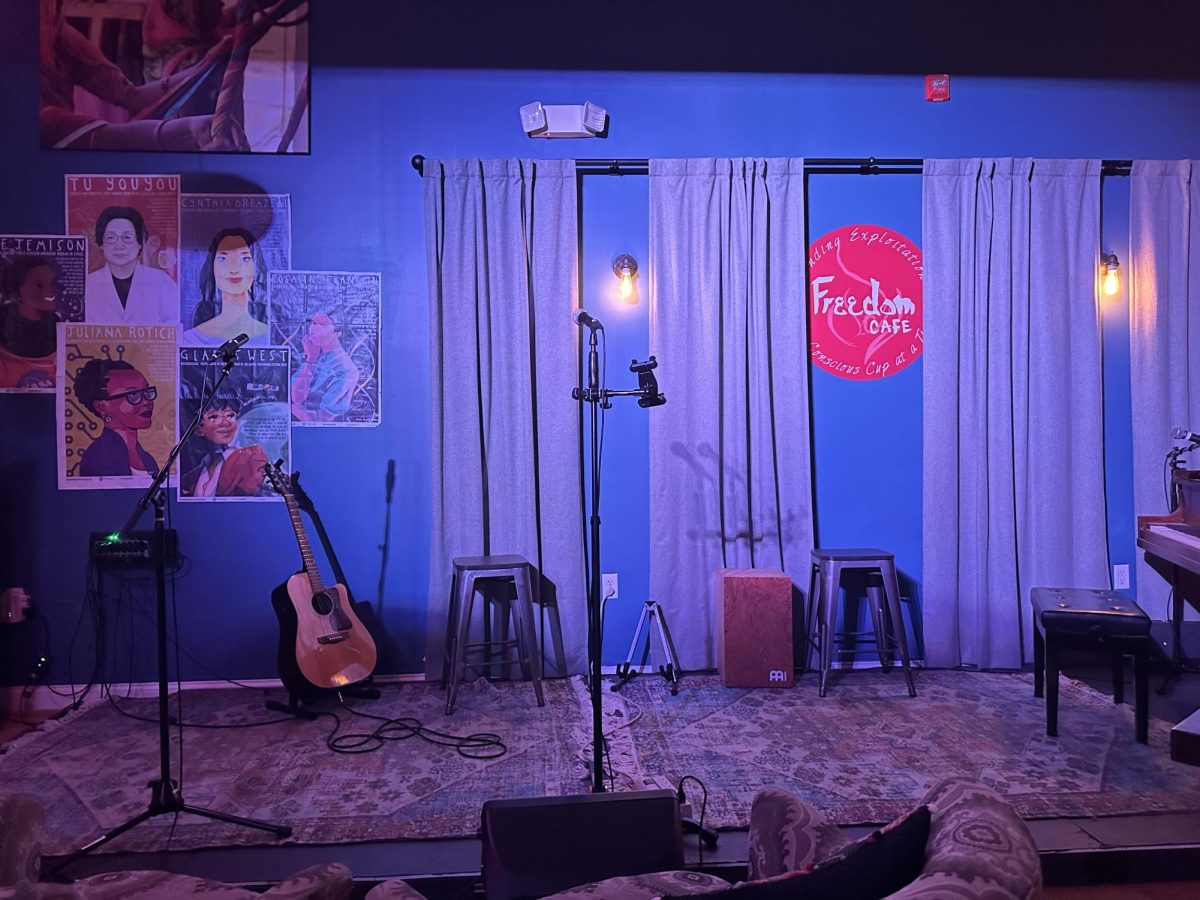A Durham-based artist’s latest mural reflecting the multi-faceted realities of suicide in society and her own life is now on display at the Dover City Hall.
The mural, titled “Missing,” was painted by Amy Issa and is currently located by the entrance to the hall’s city clerk’s office; the Dover City Council unanimously passed a resolution allowing its installation on Wednesday, Feb. 13, according to Foster’s Daily Democrat.
According to Issa, in an interview with The New Hampshire, the mural aims to illustrate the effects of individual suicide and its aftermath on loved ones, and the impact of their absence on the rest of their lives. When looking at the abstract and technicolor mural, some people in the painting can be seen with holes in their bodies, symbolizing how one’s suicide takes both their own life and an irreplaceable part of another person’s life as well.
Issa’s primary inspiration for creating the mural and working to publicly display it stems from her son, who attempted suicide last summer, a culmination of his longer struggle with depression.
“He became ill with a disorder, and this disorder was precipitated by depression. He’s had depression all his life,” she said. “He’s told me for many years he’s had depression; he’s tried to fight it in different ways. And he became so depressed during that summer, that it was really hard to get him out of bed.”
Over the summer, Issa’s son was seen by therapists and by staff at Community Partners, who attempted to create support systems for him to alleviate his depression. However, Issa said that nothing they tried, ranging from conversation to medication, had an impact on his condition, which worsened to the point where, according to Issa, he did not want to eat. He attempted suicide through an overdose on various medications shortly after support staff tried to use Prozac – a selective serotonin reuptake inhibitor (SSRI) – to combat the illness.
“When someone is very, very depressed and they take an anti-depressant like that, they get just enough energy – this is what was explained to me – they get just enough energy to actually go through with the plan that they’ve been planning,” Issa said. “So, it’s a strange thing, and I still don’t understand it fully; what I do understand is that he was so depressed that it was so debilitating, and no amount of love or understanding or support could pull him out of it. He couldn’t pull himself out of it.”
Her son went through intensive care following the attempt, and while he survived, Issa said she could not fully understand why he would want to end his life. As her son recovered, Issa sought a visual and artistic way to share her experiences and spread awareness of suicide, eventually settling on the “Missing” mural she ultimately submitted to the Dover Arts Commission.
Jane Hamor, a co-chair of the commission, told The New Hampshire that artists are free to submit any work of art they want to potentially display through an online application found on the commission’s website. The commission then reviews and considers the submissions at their monthly meetings to determine their appropriateness and message, as well as whether it fits within the commission’s mission of promoting positive local art within the Garrison City; the approved submissions are then sent to City Hall for final display approval. Hamor said the commission does not typically reject a submission unless it features “questionable content” or when a suitable location for the work cannot be found.
“In this particular case, Amy… submitted an application, but she wasn’t sure where she wanted to put the work. And so, the application was incomplete because we ask people to say where they want to complete the work and ask them to reach out to whoever the department head of that area is,” Hamor said.
Per the co-chair, the commission worked with Issa to find the best location for the mural. Issa originally wanted it hung outdoors at Henry Law Park, but the commission suggested an indoors display due to concerns over vandalism and exposure to the elements. When Issa finally completed the mural, the commission found that an outdoor display was impractical given the New England winter weather, before settling on a new area inside of City Hall near the city clerk’s office due to high visibility and the lack of other visuals in that section of the building. The co-chair added that the commission did not receive additional or similar applications seeking for art like “Missing” to be hung in the same location.
All the while, Hamor stresses that the commission aims to help as many artists be displayed as possible, even if they face difficulties with the application process itself.
“So basically, what we did was try to guide her through this process because we want artists to want to put public art up around the city,” she said. “… we probably do not get as many applications as we wish we did, so we really encourage artists to submit work that can be displayed in public places. The city is really supportive of having public art installations throughout the city, so we try to encourage it as much as we can.”
For Issa, a graduate of the College for Lifelong Learning (part of the University System of New Hampshire) with a bachelor’s degree in behavioral science who is making strides to start her own painting business, “Missing” stands as more than an eye-catching public display of art, but also as a symbolic representation of depression and its impacts on those who have it or know someone who is depressed. It also stands as a reminder that suicide can happen to and affect anyone at any time, a struggle that is both personal and universal.
“As his mother, I want to fix it,” she said. “… While I was in [the hospital], you know, I got this visual of how… could I express this and share it, because I know we are not the only family. So, I thought, well, I would do a painting to maybe bring some awareness. Maybe, in my mind, I’m thinking, if it could speak to someone, maybe someone might see it and think about, if they were that person that was thinking about it, maybe it would touch them in some way; or maybe they knew somebody that was thinking about it or that was really depressed, maybe it would make them reach out more or maybe just start a conversation about it.”
If you or someone you know are suffering with mental health issues, reach out to Psychological and Counseling Services (PACS) at 603-862-2090, or visit their office on the third floor at Smith Hall.
Categories:
Local artist sorts through son’s depression and suicide attempt with new mural
March 7, 2019
0
More to Discover






















